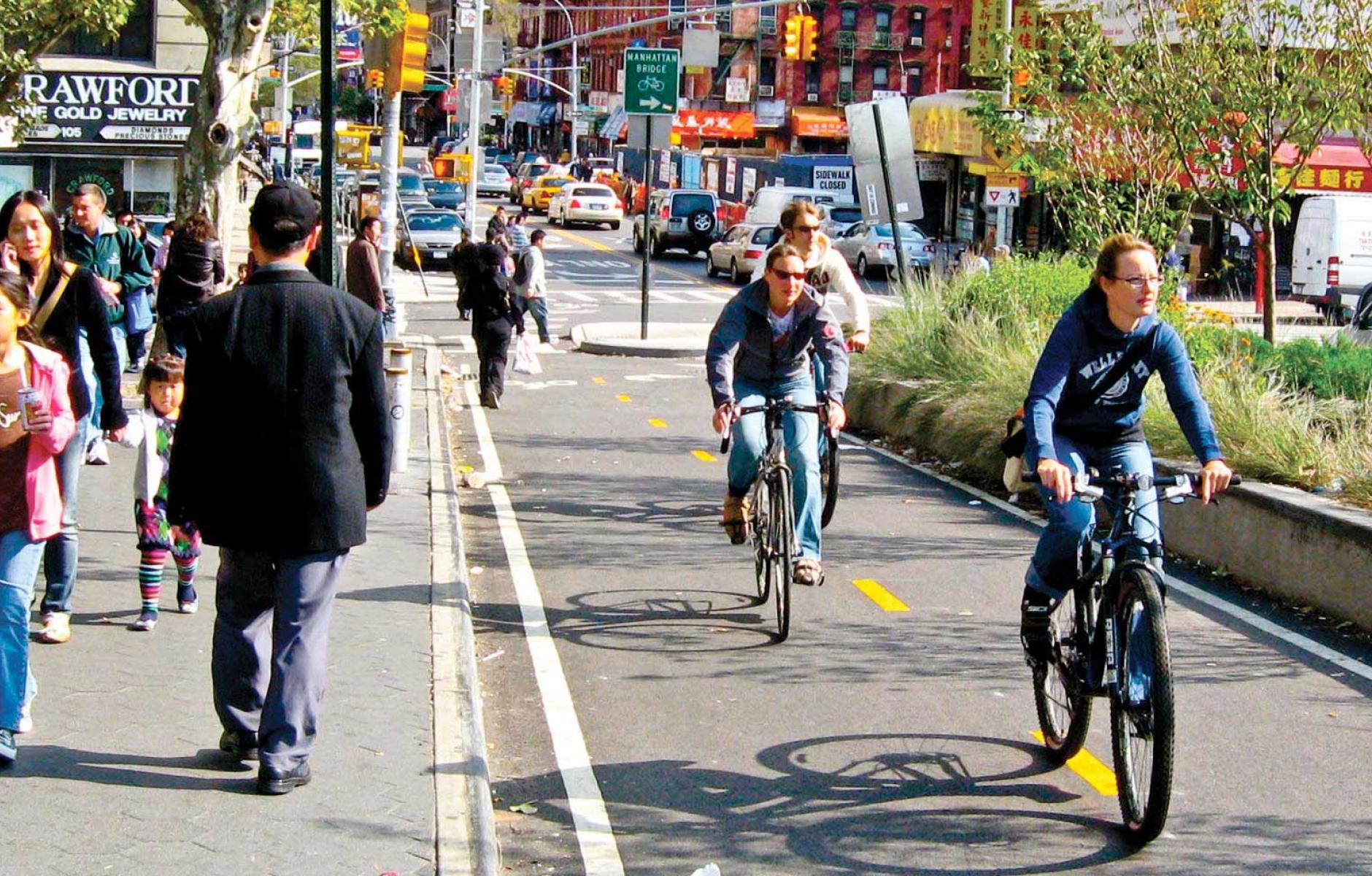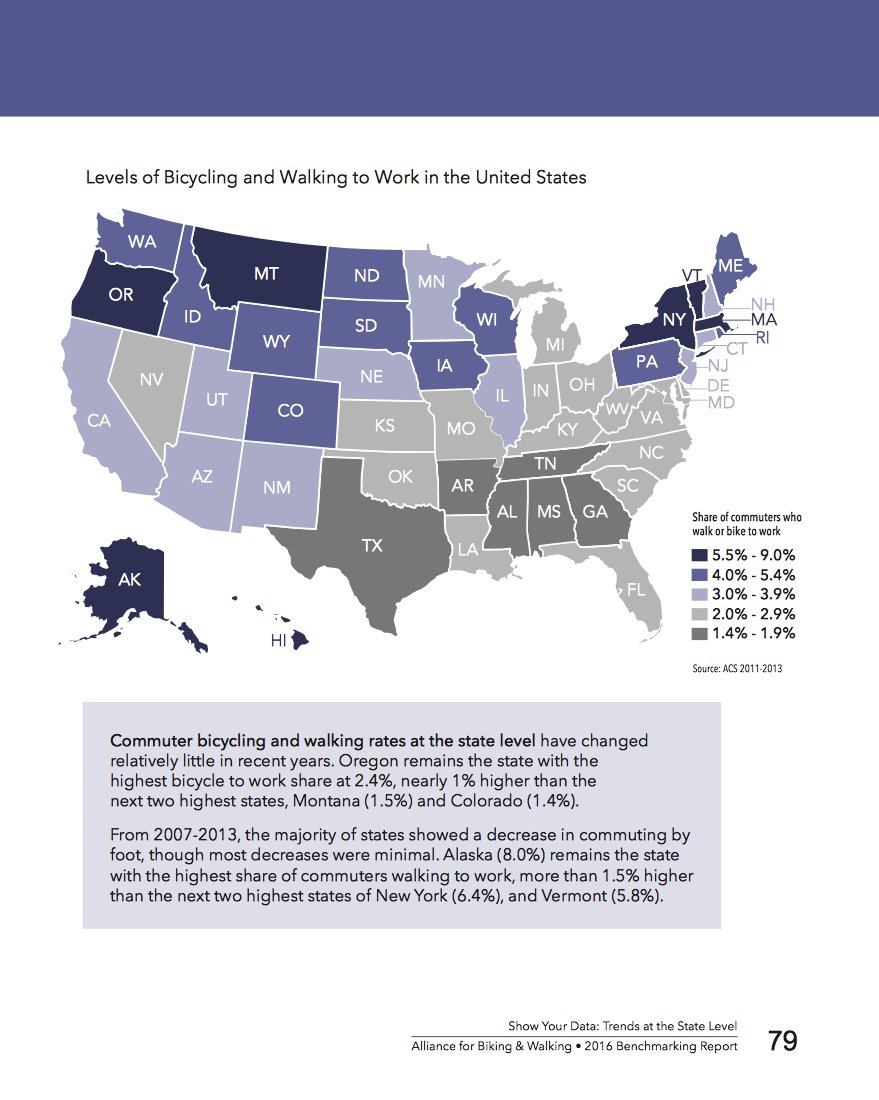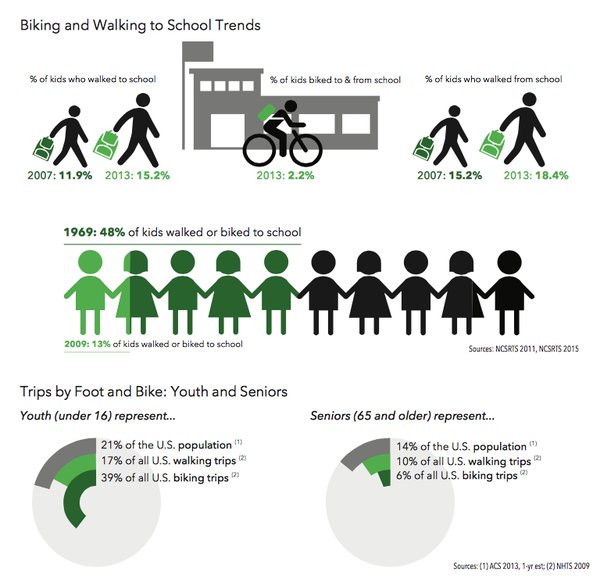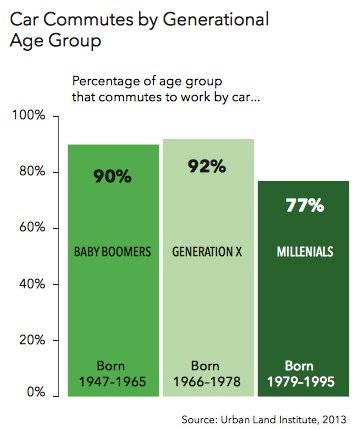
Biking and walking: How are we doing?
As spring tempts us to pick up the pace of our outdoor activities, it’s clear that not all places have equal footing. Those well-positioned to draw us out into health-boosting active transportation are enjoying all sorts of benefits. City planners across North America are trying hard to even the playing field. The 2016 Benchmarking Report for Bicycling and Walking in the United States came out earlier this month, and if you haven’t taken the time to read it yet, here are some of the important highlights in this biennial review published by the Alliance for Biking & Walking.
Safety
It’s getting safer to walk and cycle in the United States. Active transportation is on the rise, with bicycling up 71 percent from 2007 to 2016 in large U.S. cities.
That tells us that people are getting better about deciding which streets are links and which ones are places. But that we still need to work on the disproportionate fatality rate of our elders and people of color while cycling and walking. As well as the fact that men still outnumber women cycling to work, by about two to one.
For all images, click for a larger view or download here: Bicycling and Walking in the United States: 2016 Benchmarking Report.
Jobs
More jobs are created per dollar spent on pedestrian and cycling amenities than on car-only investments. We’ve talked extensively about the economics of placemaking here on PlaceShakers, so it’s good to add more jobs numbers.
Winter Walkability
I’ve had a lot of fun thinking about what makes for great walkable winter cities in the last few months, and so I was particularly happy to see that people who live in winter states are more likely to walk or bike to work. When my fellow winter city dwellers tell you, “It’s too cold to walk here,” you can once again point out that Alaska remains the state with the highest share of commuters walking to work!
Walk or Bike to School
Back in 1969, almost half of American kids walked or biked to school. 40 years later, just 13 percent of kids walk or bike to school. Still, that’s up from 2007, so we’re on a slow recovery but we have a whole lot to learn about raising free-range kids in playborhoods and playsheds.
Health
“States with higher levels of bicycling and walking to work see lower levels of diabetes, obesity, and high blood pressure. Unfortunately, every state saw a rise in each disease, but the smallest increases were seen in states with higher levels of walking and biking, including Colorado, Hawaii, and Montana.”
Car Commuters
77 percent of Millennials commute by car, in comparison to 92 percent of Gen X and 90 percent of Boomers. 85 percent of high school seniors had a driver’s license back in 1996, while only 73 percent bothered to get one in 2010. Here’s our take on the generational forces at play in city planning dynamics.
When you take time to read the full Report for Bicycling and Walking make sure to do the worksheets starting on page 156 to see how your local particulars measure up.
The Great Good Place
As I reviewed the report, I couldn’t help but think about Ray Oldenburg’s The Great Good Place, which I’ve been slowly rereading. That’s because if we’re really going to reap the benefits of walking and cycling, we have to nurture engaging neighbourhoods to tempt us out of doors in the first place, and provide a useful walk to our daily needs. As inspiration, here is a litany of some of my favourite Oldenburg quotes:
“The three realms of experience – domestic, productive, and sociable – provide both the basis and the celebration of community.”
The first place is home, the second place is work, and the third place is the neutral ground of the “gathering place.” Here, friends meet without the onus of hosting, to share a coffee, glass of wine, view of the park, hunt for books in a library, or a casual encounter over a purchase. “The gristmill, grain elevator, soda fountain, and candy store are places that did not reduce a human being to a mere customer.”
“The neutral ground of the third place, where one is neither host nor guest, offers great ease of association so important to community life. Gathering places are ‘levellers,’ where status becomes unimportant.“
“Life without community has produced, for many, a lifestyle consisting mainly of a home-to-work-and-back-again shuttle. Our urban environment is like an engine that runs hot because it was designed without a cooling system of gathering places.”
“Zoning ordinances were enforced all over the land, prohibiting the stuff of community from intrusion into residential areas.”
“Suburban zoning replaced Jane Jacobs’ ‘public characters’ with national retailers in strip centers and malls.”
“If we valued fraternity as much as independence, our zoning codes would not enforce social isolation. Zoning for monocultures of single uses creates sterile rows of regimented loneliness.”
Desire for walkable, bikeable places often gets hung up on how to implement the local vision. And that often comes down to our zoning codes, which are predominately framed around driving. Here’s to all of the places that are changing the rules to get moving and put a little spring in our step!









